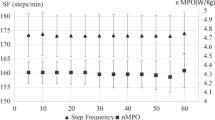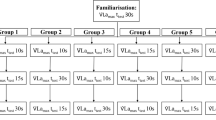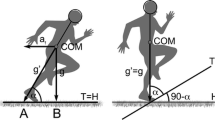Abstract
The purpose of the present study was to evaluate the effect of three pacing strategies upon performance of the 400-m sprint. Eight healthy male physical education students participated in this study. Each participant performed a 200-m maximal test (200MAX) and three 400-m running tests in a random counterbalanced design. The 400-m tests were run with the first 200-m pace set at 98% (40098%), 95% (40095%), and 93% (40093%), respectively, of the effort for 200MAX. The stimulation of the lactate system was assessed by post-test blood lactate concentration (BLa). Running speed (RS) was controlled with time-keeping devices. Stride frequency (SF), stride length (SL) and lower extremity kinematics were acquired with video cameras operating at 100 fps at the 125 and 380-m marks of the tests. A two-way analysis of variance (ANOVA) with repeated measures was used to identify modifications caused by the pacing strategies used. Non-significant differences were revealed for BLa. The fastest 400-m race was run in 40093%, but performance was not significantly different (p > 0.05) among the examined pacing strategies. RS, SF and SL had significantly (p < 0.05) lower values in the 380-m mark when compared with the 125-m mark. In 40098%, both SF and SL decreased by approximately 13%, while SF and SL dropped 2.4 and 9.2%, respectively, in 40093%. In conclusion, lower peak BLa and less unfavorable modifications of running mechanics were recorded in 40093%, where time differential between the halves of the 400-m race was smaller, which eventually resulted in better performance.

Similar content being viewed by others
References
Abbiss CR, Laursen PB (2008) Describing and understanding pacing strategies during athletic competition. Sports Med 38(3):239–252
Bret C, Rahmani A, Dufour AB, Messonnier L, Lacour JR (2002) Leg strength and stiffness as ability factors in 100 m sprint running. J Sports Med Phys Fitness 42(3):274–281
Bruggemann GP (1996) Influence of fatigue on lower extremity function. In: Proceedings of the 14th international conference on biomechanics in sports, pp 29–36. http://w4.ub.uni-konstanz.de/cpa/article/view/2666/2498. Accessed 05 June 2010
Brughelli M, Cronin J (2008) A review of research on the mechanical stiffness in running and jumping: Methodology and implications. Scand J Med Sci Sports 18(4):417–426
Chapman AE (1982) Hierarchy of changes induced by fatigue in sprinting. Can J Appl Sport Sci 7(2):116–122
Chelly SM, Denis C (2001) Leg power and hopping stiffness: relationship with sprint running performance. Med Sci Sports Exerc 33(2):326–333
Clauser CE, McConville JT, Young JW (1969) Weight, volume, and center of mass of segments of the human body. Technical Report AMRL-69–70. Wright Patterson Air Force Base, Ohio
Dempster WT (1955) Space requirements of the seated operator. Technical Report WADC-TR (55–159). Wright Patterson Air Force Base, Ohio
Duffield R, Dawson B, Goodman C (2004) Energy system contribution to 100-m and 200-m track running events. J Sci Med Sport 7(3):302–313
Duffield R, Dawson B, Goodman C (2005) Energy system contribution to 400-metre and 800-metre track running. J Sports Sci 23(3):299–307
Ferro A, Rivera A, Pagola I, Ferreruela M, Martin A, Rocandio V (2001) Biomechanical analysis of the 7th World Championships in Athletics Seville 1999. New Stud Athl 16(1/2):25–60
Foster CA, Schrager M, Snyder AC, Thompson NN (1994) Pacing strategy and athletic performance. Sports Med 17(2):77–85
Gajer B, Hanon C, Thepaut-Mathieu C (2007) Velocity and stride parameters in the 400 metres. New Stud Athl 22(3):39–46
Gambetta V (1978) Training and technique for the 400 meter dash. Track Field Q Rev 78(3):41–48
Girard O, Micallef J-P, Millet GP (2010) Changes in spring-mass model characteristics during repeated running sprints. Eur J Appl Physiol. doi:10.1007/s00421-010-1638-9
Graubner R, Buckwitz R, Landmann M, Starke A (2009) Final report: sprint men. In: Hommel H (Project Coordinator), Biomechanical analyses at the 12th I.A.A.F. World Championships in Athletics, Berlin 15–23 August 2009, Deutscher Leichtathletick-Verband, Darmstadt, pp 13–14
Green JM, Sapp AL, Pritchett RC, Bishop PA (2010) Pacing accuracy in collegiate and recreational runners. Eur J Appl Physiol 108(4):567–572
Hanon C, Gajer B (2009) Velocity and stride parameters of world class 400-meter athletes compared with less experienced runners. J Strength Cond Res 23(2):524–531
Hanon C, Thepaut-Mathieu C, Vandewalle H (2005) Determination of muscular fatigue in elite runners. Eur J Appl Physiol 94(1–2):118–125
Hanon C, Lepretre PM, Bishop D, Thomas C (2010) Oxygen uptake and blood metabolic responses to a 400-m run. Eur J Appl Physiol 109(2):233–240
Harman C (2002) A biomechanical power model for world-class 400 metre running. In: Cohen G, Langtry T (eds) Sixth Australian conference on mathematics and computing in sport. University of Technology, Sydney, pp 155–166
Hausswirth C, Le Meur Y, Bieuzen F, Brisswalter J, Bernard T (2010) Pacing strategy during the initial phase of the run in triathlon: influence on overall performance. Eur J Appl Physiol 108(6):1115–1123
Hautier CA, Wouassi D, Arsac LM, Bitanga E, Thiriet P, Lacour JR (1994) Relationships between postcompetition blood lactate concentration and average running velocity over 100-m and 200-m races. Eur J Appl Physiol 68(6):508–513
Hay JG (1985) The biomechanics of sports techniques, 3rd edn. Prentice-Hall, Englewood Cliffs
Hirvonen J, Nummela A, Rusko H, Rehunen S, Harkonen M (1992) Fatigue and changes of ATP, creatine phosphate, and lactate during the 400-m sprint. Can J Sport Sci 17(2):141–144
Hobara H, Inoue K, Gomi K, Sakamoto M, Muroaka T, Iso S, Kanosue K (2010) Continuous change in spring-mass characteristics during a 400 m sprint. J Sci Med Sport 13(2):256–261
Hunter JP, Marshall RN, McNair PJ (2004) Interaction of step length and step rate during sprint running. Med Sci Sports Exerc 36(2):261–271
James DV, Sandals LE, Draper SB, Maldonado-Martin S, Wood DM (2007) VO2 attained during treadmill running: the influence of a specialist (400-m or 800-m) event. Int J Sports Physiol Perform 2(2):128–136
Jarver J (2005) About the 400 m event. Track Coach 171:5474–5475
Kadono H, Ae M, Suzuki Y, Shibayama K (2008) Effects of fatigue on the ground reaction forces and leg kinematics in all-out 600 meters running. In: Harrison AJ, Anderson R, Kenny I (eds) Scientific proceedings of the 27th International congress on biomechanics in sports, University of Limerick, Limerick, pp 741–744
Kollias IA (1997a) Biomechanics of sport movement. Christodoulidi Publishers, Thessaloniki
Kollias IΑ (1997b) Sources of error and their elimination in the use of DLT with the basic recording tools for the analysis of human body in motion. Exerc Soc J Sport Sci 18:9–26
Lacour JR, Bouvat E, Barthelemy JC (1990) Post-competition blood lactate concentrations as indicators of anaerobic energy expenditure during 400-m and 800-m races. Eur J Appl Physiol 61(2):172–176
Mero A, Komi PV (1986) Force-, EMG-, and elasticity-velocity relationships at submaximal, maximal and supramaximal running speeds in sprinters. Eur J Appl Physiol 55(5):553–561
Mero A, Peltola E (1989) Neural activation and stride technique in fatigue and non-fatigue conditions of short and long sprint running. Biol Sport 6:43–58
Mero A, Luhtanen P, Komi PV, Susanka P (1988) Kinematics of top sprint (400 m) running in fatigued conditions. Track Field Q Rev 88(2):42–45
Morin J-B, Jeannin T, Chevallier B, Belli A (2006) Spring-mass model characteristics during sprint running: correlation with performance and fatigue-induced changes. Int J Sports Med 27(2):158–165
Muller H, Hommel H (1997) Biomechanical research project at the VIth World Championships in Athletics, Athens 1997: preliminary report. New Stud Athl 12(2/3):43–73
Nicol C, Komi PV, Marconnet P (1991) Fatigue effects of marathon running on neuromuscular performance. I. Changes in muscle force and stiffness characteristics. Scand J Med Sci Sports 1(1):10–17
Nummela A, Rusko H (1995) Time course of anaerobic and aerobic energy expenditure during short term exhaustive running in athletes. Int J Sports Med 16(8):522–527
Nummela A, Rusko H (2000) Acclimatization to altitude and normoxic training improves 400-m running performance at sea level. J Sports Sci 18(6):411–419
Nummela A, Vuorimaa T, Rusko H (1992) Changes in force production, blood lactate and EMG activity in the 400-m sprint. J Sports Sci 10(3):217–228
Nummela A, Rusko H, Mero A (1994) EMG activities and ground reaction forces during fatigued and nonfatigued sprinting. Med Sci Sports Exerc 26(5):605–609
Nummela A, Stray-Gundersen J, Rusko H (1996) Effects of fatigue on stride characteristics during a short-term maximal run. J Appl Biomech 12(2):151–160
Ohkuwa T, Kato Y, Katsumata K, Nakao T, Miyamura T (1984a) Blood lactate and glycerol after 400-m and 3,000-m runs in sprint and long distance runners. Eur J Appl Physiol 53(2):213–218
Ohkuwa T, Saito M, Miyamura M (1984b) Plasma LDH and CK activities after 400 m sprinting by well-trained sprint runners. Eur J Appl Physiol 52(3):296–299
Pinniger GJ, Steele JR, Groeller H (2000) Does fatigue induced by repeated dynamic efforts affect hamstring muscle function? Med Sci Sports Exerc 32(3):647–653
Quinn M (2004) The effects of wind and altitude in the 400-m sprint. J Sports Sci 22(11):1073–1081
Reis VM, Miguel PP (2007) Changes in the accumulated oxygen deficit and energy cost of running 400 metres. New Stud Athl 22(2):49–56
Reis VM, Duarte JA, Espirito-Santo J, Russell AP (2004) Determination of accumulated oxygen deficit during a 400 m run. J Exerc Physiol online 7(2):77–83
Sandals LE, Wood DM, Draper SB, James DV (2006) Influence of pacing strategy on oxygen uptake during treadmill middle distance running. Int J Sports Med 27(1):37–42
Saraslanidis PJ, Manetzis CG, Tsalis GA, Zafeiridis AS, Mougios VG, Kellis SE (2009) Biochemical evaluation of running workouts used in training for the 400-m sprint. J Strength Cond Res 23(8):2266–2271
Schiffer J (2008) The 400 metres. New Stud Athl 23(2):7–13
Schmolinsky G (1983) Track and Field. Sportverlag, Berlin
Simonsen EB, Thomsen L, Klausen K (1985) Activity of mono- and biarticular leg muscles during sprint running. Eur J Appl Physiol 54(5):524–532
Slawinksi J, Dorel S, Hug F, Couturier A, Fournel V, Morin J-B, Hanon C (2008) Elite long sprint running: a comparison between incline and level training sessions. Med Sci Sports Exerc 40(6):1155–1162
Smith M (1994) 400 m pace control. Athl Coach 28(2):13–14
Spencer MR, Gastin PB (2001) Energy system contribution during 200- to 1500-m running in highly trained athletes. Med Sci Sports Exerc 33(1):157–162
Spencer MR, Gastin PB, Payne WR (1996) Energy system contribution during 400 to 1500 metres running. New Stud Athl 11(4):59–65
Sprague P, Mann RV (1983) The effects of muscular fatigue on the kinetics of sprint running. Res Q Exer Sport 54(1):60–66
Stukolov A, Mansvetov V (1981) On the track with Victor Markin. Soviet Sports Rev 16(4):178–181
Tesch P, Sjodin B, Thorstensson A, Karlsson J (1978) Muscle fatigue and its relation to lactate accumulation and LDH activity. Acta Physiol Scand 103:413–420
Thelen DG, Chumanov ES, Hoerth DM, Best TM, Swanson SC, Li L, Young M, Heiderscheit BC (2005) Hamstring muscle kinematics during treadmill sprinting. Med Sci Sports Exerc 37(1):108–114
Tupa V, Gusenov F, Mironenko I (1995) Fatigue influenced changes to sprinting technique. Modern Athl Coach 33(3):7–10
van Coppenolle H (1980) Analysis of 200-metres intermediate times for 400-metres world-class runners. Track Field Q Rev 80(2):37–39
Weyand PG, Cureton KJ, Conley DS, Sloniger MA, Liu YL (1994) Peak oxygen deficit predicts sprint and middledistance track performance. Med Sci Sports Exerc 26(9):1174–1180
Weyand PG, Sternlight DB, Bellizzi MJ, Wright S (2000) Faster top running speeds are achieved with greater ground forces not more rapid leg movements. J Appl Physiol 89(5):1991–1999
Whitsett CE (1963) Some dynamic response characteristics of weightless man. Technical Report AMRL-TDR-63–18. Wright Patterson Air Force Base, Ohio
Wiemann K, Tidow G (1995) Relative activity of hip and knee extensors in sprinting–Implications for training. New Stud Athl 10(1):29–49
Winter DA (1990) Biomechanics and motor control of human movement, 2nd edn. Willey, Toronto
Wood GA (1986) Optimal performance criteria and limiting factors in sprint running. New Stud Athl 1(2):55–63
Yu B, Queen RM, Abbey AN, Liu Y, Moorman CT, Garrett WE (2008) Hamstring muscle kinematics and activation during overground sprinting. J Biomech 41(15):3121–3126
Acknowledgments
The authors wish to thank the two anonymous reviewers for their valuable feedback on an earlier version of the manuscript. Appreciation is extended to Mr. George G. Dales, President of the International Track and Field Coaches Association (I.T.F.C.A.), for his assistance and inspiration during this project.
Conflict of interest
The authors declare that they have no conflict of interest.
Author information
Authors and Affiliations
Corresponding author
Additional information
Communicated by Jean-René Lacour.
Rights and permissions
About this article
Cite this article
Saraslanidis, P.J., Panoutsakopoulos, V., Tsalis, G.A. et al. The effect of different first 200-m pacing strategies on blood lactate and biomechanical parameters of the 400-m sprint. Eur J Appl Physiol 111, 1579–1590 (2011). https://doi.org/10.1007/s00421-010-1772-4
Accepted:
Published:
Issue Date:
DOI: https://doi.org/10.1007/s00421-010-1772-4




